Wearable technology has accelerated onto the market in 2013 and is gaining major traction going into 2014. The vast amount of information at consumers’ fingertips has evolved the automotive experience and has greatly influenced the ways in which automobiles are sold. Wearable technology will alter our automotive experience in new ways from all perspectives and will completely change the vehicle shopping experience as we know it.
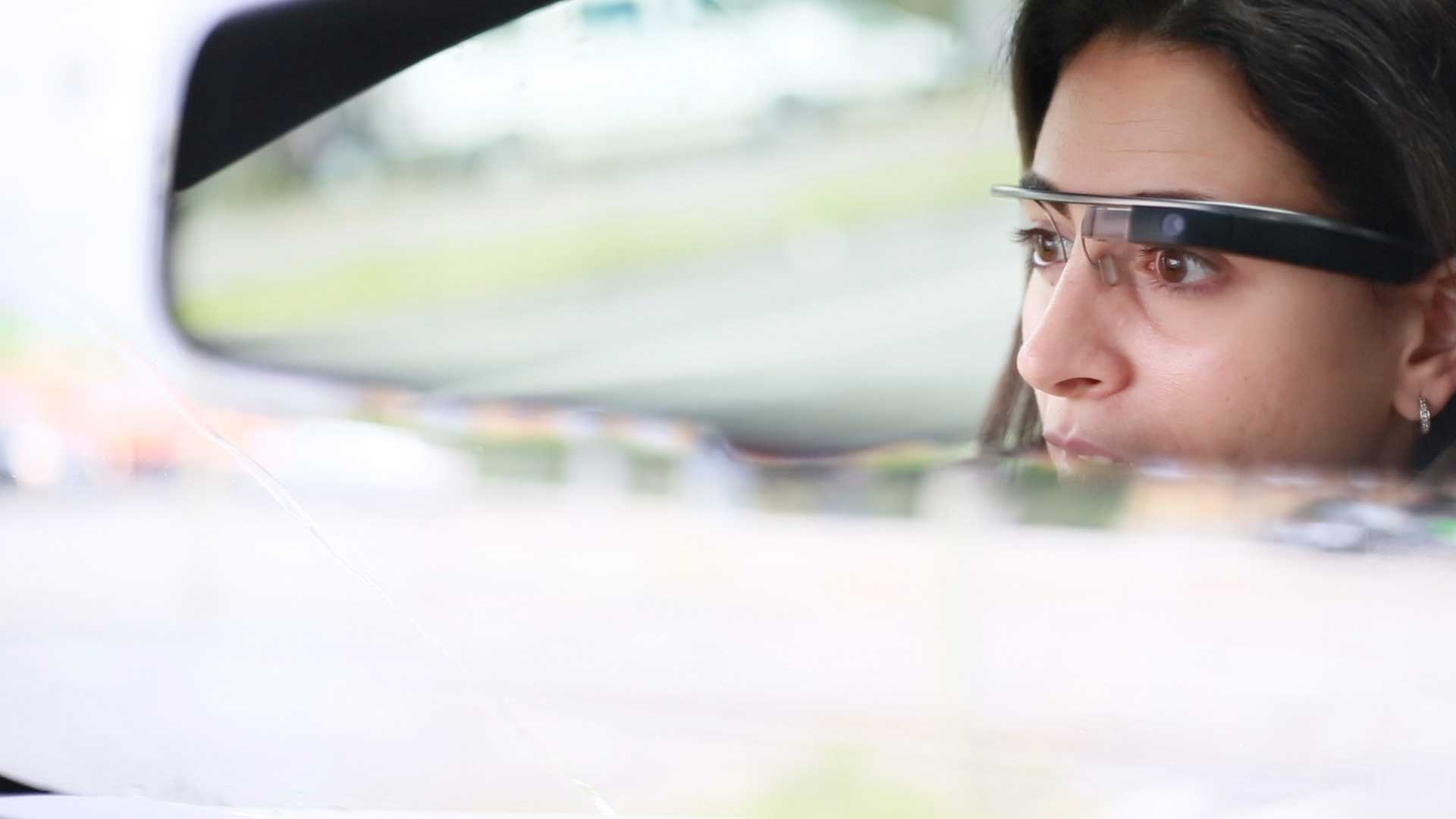 Wearable products have been around for decades, but it is only recently that they are becoming vogue and fashionable. A number of automakers have already proceeded with the uptake of wearables, sourcing inventive ways to implement the technologies in vehicles.
Wearable products have been around for decades, but it is only recently that they are becoming vogue and fashionable. A number of automakers have already proceeded with the uptake of wearables, sourcing inventive ways to implement the technologies in vehicles.
Mercedes Benz, for example, has developed the Glassware project, which is designed to work seamlessly with a car’s navigation system. Route directions are overlaid via glasses onto the road, allowing drivers to keep their eyes away from a GPS screen.
Ford, on the other hand, is seeking to use the technologies to better monitor driver health.
By knowing the condition of the driver through a variety of sensors (heart rate, for example), it’s then easier for the car to understand their mood. The vehicle could change a song to relax the driver, for example.
Wearable technology holds the potential to disrupt many markets including the automotive industry. Integrated into the connected car, wearables can bring a number of benefits to the driver and the passengers in the areas of safety, infotainment experiences, and more. In other words, wearables integration into the vehicle enables smarter mobility.
Generally, wearable technologies today come in three ‘flavors’:
- Bands (used for fitness tracking and management and health monitoring and reporting functions)
- Smart watches
- Augmented Reality technology, which presents fully-interactive devices like Google Glass.
Wearable growth
These new technologies offer a substantial number of possibilities and certainly need to be considered by fleet managers as they develop.
In fact, interest is already starting to grow, with Gartner predicting that by 2018 the head-mounted display (HMD) technology will become mainstream- thus ushering in a new era of wearables.
HMD technology is what’s found in wearables worn like glasses, overlaying useful information over the world. A driver wearing such technology could see route guidance directly on a road ahead.
What’s more, biometric sensors are also set to see a jump in adoption, with many wearable devices integrating the sensors to provide up-to-date health information to drivers.
The technologies could soon proliferate in vehicles from a number of auto makers, becoming an integral part of the driving experience.
Mr. Sanjay Gupta, R&D Director – Automotive & Industrial MCU Group, India Design Centre, Freescale Semiconductor India shared his insights on potential of wearable in automotive sector.
 “From glasses, to watches, to clothing, wearable technology is the next wave of our digital world and it is getting interweaved into automobiles as well.While, in India wearable technology is at a very nascent stage but it has the promise and potential to leave a deep impact on our daily lives.
“From glasses, to watches, to clothing, wearable technology is the next wave of our digital world and it is getting interweaved into automobiles as well.While, in India wearable technology is at a very nascent stage but it has the promise and potential to leave a deep impact on our daily lives.
Companies are already investing heavily in bringing wearable technology to the automotive domain and it will be interesting to see how wearable technology will enhance the in-car driving experience.
For example, Mercedes’ DriveStyle smartphone apps provide information such as the position of the car, door lock status or even fuel level from a distance. With its cooperation with Pebble, Mercedes plans to bring the same information to smartwatches while adding a few new features which can easily be controlled from your wrist. With the Pebble app concept, Mercedes drivers can use their smartwatches to report accidents they’ve come across and receive real-time alerts of road hazards with a buzzer on their wrist. The DriveStyle app works with all Mercedes models manufactured after 2009 which have the Mercedes drive kit plus installed. Similarly, for its first electric car, the i3, BMW has developed a smartwatch app for the Galaxy Gear that lets drivers monitor their car’s vitals and also control its features from a distance. The app, which has been presented at CES for the first generation of Samsung’s smartwatch, lets you check the battery status and driving range along with the status of the doors and windows and displays notifications of service or inspection needs. Another great feature is the ability to remotely control the car’s air-conditioning system, so the i3 has already reached the right temperature by the time you want to start your ride.
Wearable technology will be key to another emerging trend in vehicles: the hands-free, immersive experience. Already, your phone and its apps are becoming accessible in the car through voice or touch.
What is important to understand here is all these technologies will lessen human intervention. We are already in an era where we are talking about the future of driverless cars and how it can be implemented in a country like India. The evolution of wearable technology in automotive domain will further work to create a real aura around the car and the user’s experience while being inside the car.
This trend will also help the user keep a real time check on the car’s fuel, battery, and many other such things. It will further enhance the growing concept of mobility and help the user to be updated about his car and its functional needs.
We work with ecosystem partners and supply them solutions and platforms to develop wearables and we are ready to explore something for the automotive domain considering our expertise in the field and the requirement from our partners.
Insights from K Md. Feroz Irfan, Technical Lead, Automotive, Sales & Applications, Texas Instruments India
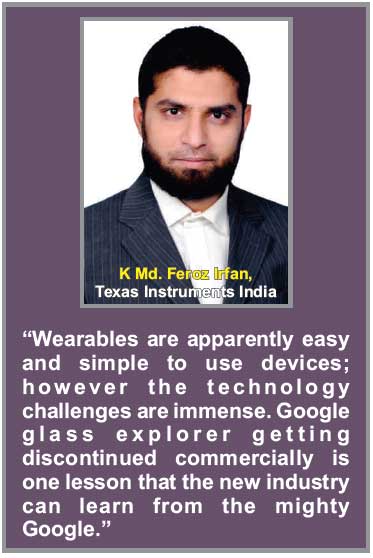 Smartphones and tablets are proliferating at a phenomenal pace, garnering a lion’s share of total mobile devices with over 2 billion devices sold in 2014. The stage is set for their smart cousins and potentially their natural successors – the Wearables.
Smartphones and tablets are proliferating at a phenomenal pace, garnering a lion’s share of total mobile devices with over 2 billion devices sold in 2014. The stage is set for their smart cousins and potentially their natural successors – the Wearables.
The Automobile is seen as the next frontier for technology companies to conquer consumer mind share. No wonder we see car OEMs and new thought leaders entering into the space, wanting to add value and capture every possible byte of user experience. This also calls for connectivity and interoperability with smart devices that people carry or wear every day.
The game of differentiation is catching on among the Car OEMs like Ford, Mercedes, BMW building smart apps and experiences as described in a later section of this cover story.
Wearables are apparently easy and simple to use devices; however the technology challenges are immense. The Google Glass explorer getting discontinued commercially is one lesson that the new industry can learn from the mighty Google. Building a successful Wearable product is indeed demanding. Critical parameters include interoperability with existing and future car dashes – securely, Coexistence with diverse devices and technologies in the vicinity, Long lasting battery with easy recharge, small form factor and light weight, all the while being aesthetic, practicable, affordable, legally approved and easy to use.
Electronics are certainly the heart and brains of smart wearables which primarily determine the above mentioned critical success factors. A wearable could consist of a Processor /Microcontroller interfaced with a sensor group, with a display and/or LEDs, connectivity technologies, Power management, Battery and charge management system, Haptics drivers, Accelerometers/ gyros, LCD backlights etc.
For Texas Instruments these building blocks are sweet spots of strategic stature.
TI Technologies
Connectivity – Clearly the core technology for wearables for secure and seamless interoperability. TI has the industry’s widest portfolio of Wireless technology spanning across 14 standards like Wi-Fi, BT, BT Smart, NFC, ZigBee,RF4CE etc. with generations of devices already deployed. Particularly relevant for wearables is the SimpleLink family of low and ultra low power wireless offerings– Wireless MCUs and Network processors enabling connectivity to the IoT as detailed below.
BT/BT Smart – With 7 billion devices BT/BTLE are favorites for in Car wearables. TI supports ultra-low power offerings for BT, BTLE or Combo ICs with features like in-built MCU with master/slave support, robust software and over the air upgrade support. The latest ultra-low power platform C26xx supports BT Smart, ZigBee, 6LowPAN, Sub 1GHz and proprietary modes up to 5Mbps expanding the family into the broadest, lowest power and easiest to use in the industry.
Wi-Fi – TI has been a renowned supplier of potentially the most ubiquitous IoT technology – the first to release an 802.11n way back in 2009. TI has a SimpleLink family called CC31xx/CC32xx with Wireless network processors, inbuilt TCP/IP stack, security supplicant etc. supporting low -power modes for battery operation in wearables. Teams without prior Wi-Fi experience can build systems easily hence with quick turnaround time. The Wilink 8 family can also be used for Wi-Fi when it’s needed in combination with BT/BTLE (coexisting over single antenna) and GPS systems.
NFC – A technology of choice for Medical sensor patches, in-vehicle payments systems, Secure Access, quick data transfer from the wearable to the Auto dash etc. TI has compelling offerings with Reader/Writer ICs, Passive and Dynamic Tag ICs, innovative embedded NFC tag solutions, Best RF performance, Strong software support. TI enables battery less secure NFC RF430 SoCs supporting all 3 NFC modes and support static and dynamic tags complying to ISO15693 Tag type 5 and ISO 14443B.
Battery management – TI has the broadest Portfolio of Wireless Charging ICs, Nano-Power Harvesting ICs, Traditional Chargers and Gauges – with the smallest footprint for tight form factors. They provide very high-efficiencies allowing lower heat dissipation and longer battery run times.
Sensors & Sensor AFE (Analog front end) – The eyes and ears of the Wearables a variety of them exist. TI has sensors and sensor signal conditioners (AFEs) for pressure, position, temperature, etc.
Haptics Drivers – Haptics refers to the sense of touch and adds tactile feedback to wearables by use of vibrations. TI offers a complete line of haptic drivers which have the ability to drive eccentric rotating mass (ERM), Linear resonant actuator (LRA) and piezoelectric actuators.
Wireless Charging – TI has been working for several years in the development of this technology, and is a market leader in Qi wireless power solutions. BQ51003 is one such device with Advanced, integrated receiver for wireless power transfer.
MCU – MCUs for auto wearables need to be low power, robust, secure and real time to react to some critical notifications in the vehicle. For applications like automotive vehicle access, MCUs with integrated RF and security features help build smaller form factor products. TI has some of the lowest power MCUs with MSP430 family tending towards battery less designs while being capable of real time control, with rich connectivity suited for secure and safety applications.
In summary, the future is sure bright for the smart wearables category and TI with its huge portfolio of 100,000 ICs and its strategic focus on Analog, Power Management, Connectivity, MCUs, etc. will continue to be a reliable and trusted partner of the wearable industry to drive further innovations in and around the automobile.
Insights from Richard Barrett, Broadcom Director of Wireless Connectivity, Automotive
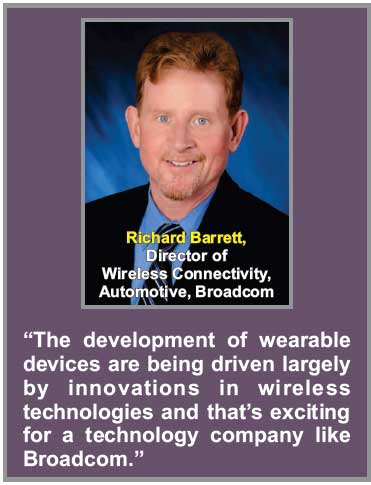 One of the key developments ramping the wearables market is the power-saving technology of Bluetooth Smart or Bluetooth Low Energy (BLE). With BLE, products are able to function with so little power that batteries can potentially last for months or even years on a single charge.
One of the key developments ramping the wearables market is the power-saving technology of Bluetooth Smart or Bluetooth Low Energy (BLE). With BLE, products are able to function with so little power that batteries can potentially last for months or even years on a single charge.
The first wave of wearable devices to connect to the car is the smartwatch. Nissan recently introduced its Nismo smartwatch, which monitors average vehicle speeds, fuel consumption, and the driver’s heart rate, temperature and other biometrics. Ford recently announced its plans to incorporate the use of wearable technology within the vehicle to improve safety. And Mercedes cooperation with Pebble has resulted in an app where Mercedes drivers can use their smartwatch to report accidents they’ve come across and receive real-time alerts of road hazards with a buzzer on their wrist.
Automotive connectivity with wearable devices has enormous potential. The next class of devices will revolve around applications that allow the user to control simple operations within the vehicle’s interior using a smartphone, such as seat settings, climate control, remote start, tire pressure, and keyless entry.
As the technology continues to take hold, wearable sensors will enable the car to make decisions based on biometric data such as heart rate, blood pressure r, pulse rate, glucose and even blood alcohol content.
There is no doubt that wearables will play a big role how we interact with our cars. Feeling relaxed, stressed or sleepy while driving? With wearable technology, the car of the future will monitor your vital signs to ensure you are fit to drive, and if it concludes you are not, it might take over the wheel to prevent an accident.
The automotive industry is now readily adopting the range of technologies that will make the scenarios presented above a reality.
Broadcom offers an array of solutions optimized to spur innovation in the fast growing wearable and automotive markets.
Wireless Internet Connectivity for Embedded Devices (WICED™) Development Platform
Broadcom’s WICED™ line of development platforms and design kits allow inventors and OEMs to create connected devices with little need for hardware expertise or expensive prototyping. This means faster time-to-market, smoother development cycles and lower costs.
Broadcom’s latest addition to the WICED platform is WICED Sense, an affordable entry point to the ever-expanding wearable tech ecosystem. It delivers complex technology in an easy-to-use and easy-to-understand development kit. The kit consists of a Bluetooth Smart chip, SIP Module, five micro-electromechanical sensors (MEMS) and Broadcom’s flagship WICED™ SMART software stack.
Automotive Bluetooth® Software Stack
Broadcom’s automotive Bluetooth software stack enables seamless in-car connectivity with Android-powered wearable devices. Integrated Bluetooth Smart Ready technology syncs easily with wearable devices to monitor driver health and biometric indicators such as driver fatigue and blood alcohol content. Broadcom’s Android Automotive Bluetooth software combines Broadcom’s proven expertise in software development and widely deployed wireless connectivity with high performance profiles optimized for use in the evolving automotive environment.
Automotive-grade Wi-Fi/Bluetooth Smart Combo Chips
Featuring the latest in 5G WiFi and Bluetooth Smart Ready technology, Broadcom’s wireless automotive chips allow drivers and passengers to easily sync and stream content from mobile devices to the car’s infotainment system and rear-seat displays. The automotive-grade chips also enable high-speed connectivity beyond the vehicle, serving Internet and cloud content via LTE telematics or directly from a hot spot connection.
Insights from Navin Honnavar, Sr.Manager – Marketing (South Asia), element14

The boom in technology space has been phenomenal over the past few years. Technology truly has an impact on society when it helps us make a process or way of life more productive and beneficial. The future as we know holds a huge market for wearable technology due to the advances the sector has seen off late. From clothing, to watches and even glasses, wearable technology is the next wave of our digital world which is interweaving with our automotive lives. We will witness vehicle-to-person interaction level becoming much higher with our vehicles. A variety of devices will now be connecting us to our automobiles giving us new levels of control and interaction. Wearables in the near future will be offering great opportunities to enhance driving experience.
Some critical features like warning systems are already being implemented in a few automotive vehicles. For instance, warning systems being interactive with steering wheels and seats utilizing vibration and motion to warn the driver in emergency situations. This technology enhances the driver’s reaction time, increases overall awareness and allows controlling the vehicle in more detailed manner. Very soon wearable products such as gloves, jackets and helmets are expected to hit the market. This technology will be loaded with collaborative technology that will take ones inputs and mental simulations and incorporate it directly into ones driving experience.
Some of the technology already being implemented is:
Smartwatches and the Car
Smartwatches provide customers information such as the position of the car, door lock status and even fuel level which can be all accessed from one’s wrist. Drivers can use their smartwatches to report accidents they’ve come across and receive real-time alerts of road hazards with a buzzer on their wrist. In case of electric cars, a smartwatch will assist the drivers to monitor their car’s vitals and also control its features from a distance. Another innovative feature is the ability to remotely control the car’s airconditioning system so that the car has already reached the right temperature by the time the driver gets to his vehicle. Smartwatch concept measures several car metrics such as average speed and fuel consumption and also monitors the drivers’ heart-rate in order to detect early signs of fatigue. This particular feature can be used by professional car racers which will help them keep a track of their vital rate.
Smartglasses and the Car
The industry is already working on technology which could make driving more convenient as well as safer. Smartglassescan be extremely useful for easier navigation. The car owners do not necessarily need to replace the car’s built-in navigation system while driving. Instead they can use a smartglass after parking the car to receive navigation support. In some cars the instruction manual could directly appear in front of the driver’s line of vision. The embedded system can run its users through service procedures, such as refilling the washing fluid. Advanced driver assistance system analyses real-time camera data and alerts drivers of potential safety threats, such as imminent collisions and unexpected obstacles, directly on the smartglasses. Smartglasses’ built-in accelerometer and infrared camera can detect drivers falling asleep and help them find a place to rest, thus making it easier for a safe drive.
Element14 does not provide end solution for the market, but focuses on helping build the marketplace by offering products which will help build the solutions. We offer design engineerslatest development kits including IOT kits, components and other solutions. With our community meant for design engineers we create opportunities for the young designers to interact with their peer groups across the world, understand cutting edge technology, and provide access to our large pool of suppliers and training content.
Cool Wearable Technologies in Car
-
Mercedes-Benz Pebble smartwatch
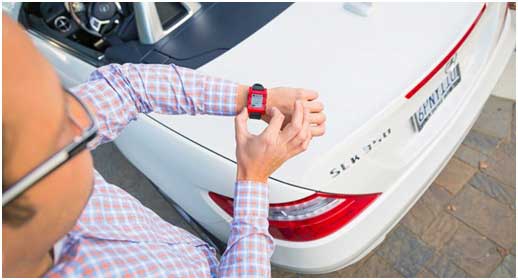 Mercedes-Benz recently collaborated with Pebble Technologies to redevelop the luxury German automaker’s Digital DriveStyle application. The idea is that drivers use the sleekly styled smartwatch to check on their vehicle’s location, door lock status and even fuel level.
Mercedes-Benz recently collaborated with Pebble Technologies to redevelop the luxury German automaker’s Digital DriveStyle application. The idea is that drivers use the sleekly styled smartwatch to check on their vehicle’s location, door lock status and even fuel level.
How does it work? Well, the smartwatch functions as a second screen for the driver’s smartphone, on which the application is installed. And just as the nifty watch can alert its wearer of incoming calls, texts and emails, so too can it in theory warn the driver of real-time hazards when behind the wheel. Mercedes says that the smartwatch vibrates before accident scenes, stalled vehicles or road construction hazards present themselves.
-
Harman’s ADAS Google Glass integration
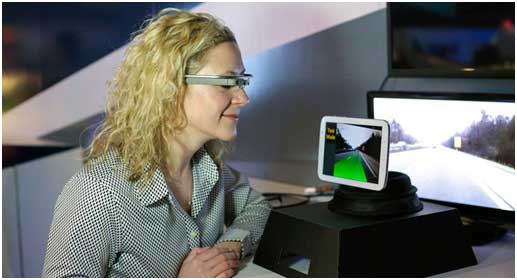 There’s an intense debate around whether Google Glass should be used while behind the wheel of a car. In fact, lawmakers in certain parts of the world have already staunchly opposed the use of such gadgets while driving.
There’s an intense debate around whether Google Glass should be used while behind the wheel of a car. In fact, lawmakers in certain parts of the world have already staunchly opposed the use of such gadgets while driving.
Harman, though, says that Google Glass could actually make you a safer driver. How? Well, the company reckons that its advanced driver assistance services (ADAS) engine is capable of sending audio-visual safety alerts directly to Google Glass. It analyses real-time camera data and picks out potential safety threats (impending collisions, unexpected obstacles, etc.), alerting the driver without distracting them from the task at hand.
-
BMW i3 Samsung Galaxy Gear smartwatch
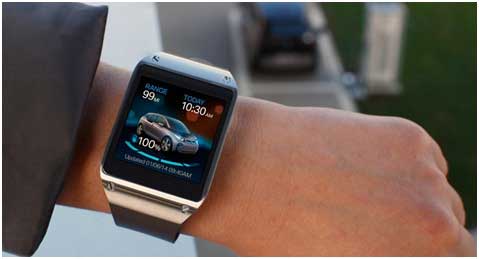 BMW’s i3 is pretty darn revolutionary. It’s all-electric. Its futuristic body makes extensive use of a new kind of carbon-fibre reinforced plastic. And, of course, it’s the first model from the i-range that the German car-maker hopes will completely alter “personal mobility”. But that’s obviously not enough for BMW.
BMW’s i3 is pretty darn revolutionary. It’s all-electric. Its futuristic body makes extensive use of a new kind of carbon-fibre reinforced plastic. And, of course, it’s the first model from the i-range that the German car-maker hopes will completely alter “personal mobility”. But that’s obviously not enough for BMW.
No, the Bavaria-based automotive giant recently teamed up with Samsung to create a smartwatch application that links the Android-based Galaxy Gear with the BMW i3. In theory, the wearer/driver is able to both monitor (battery charge, available range, door lock status, etc.) and control (air-con, heater, navigation, etc.) components of the car from their wrist. Pretty slick.
-
Hyundai’s Blue Link Google Glass app
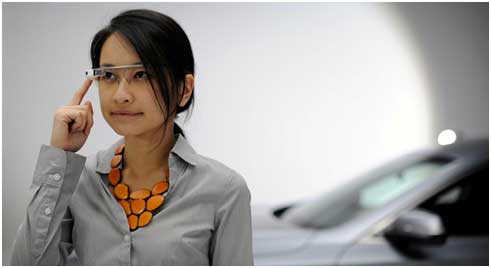 At the start of 2014, Hyundai announced that its 2015 Genesis sedan would be compatible with Google Glass, thanks to the car-maker’s clever Blue Link infotainment system. But it seems – for the time being, anyway – that the Korean manufacturer is steering well clear of the safety debate around Google Glass, preferring instead to focus on the wearable gadget’s usefulness when its owner is outside of the vehicle.
At the start of 2014, Hyundai announced that its 2015 Genesis sedan would be compatible with Google Glass, thanks to the car-maker’s clever Blue Link infotainment system. But it seems – for the time being, anyway – that the Korean manufacturer is steering well clear of the safety debate around Google Glass, preferring instead to focus on the wearable gadget’s usefulness when its owner is outside of the vehicle.
Once downloading the Blue Link Glassware app, Genesis drivers will be sent vehicle information in the form of “cards” that show up on the Google Glass interface. Hyundai says that the app will also allow owners to access popular Blue Link features such as remote start, remote door lock/unlock, and vehicle finder. In addition, push notifications will alert the car’s owner when maintenance is due, as well as allowing quick service scheduling.
-
Nissan Nismo Concept Watch
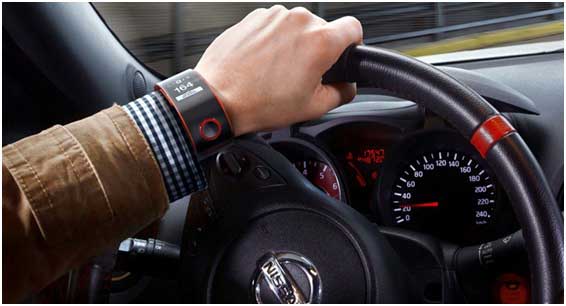 Nissan’s first step into the realm of wearable technology comes in the form of a concept smartwatch. The Japanese automaker says that the Nissan Nismo Watch – which is partly made of spent tyre rubber lifted from racetrack surfaces – will allow a driver to monitor the efficiency of their vehicle (average speed, fuel consumption, etc.) and access vehicle telematics and performance data while on track. As with similar concepts, the watch connects to the vehicle via a smartphone app using Bluetooth.
Nissan’s first step into the realm of wearable technology comes in the form of a concept smartwatch. The Japanese automaker says that the Nissan Nismo Watch – which is partly made of spent tyre rubber lifted from racetrack surfaces – will allow a driver to monitor the efficiency of their vehicle (average speed, fuel consumption, etc.) and access vehicle telematics and performance data while on track. As with similar concepts, the watch connects to the vehicle via a smartphone app using Bluetooth.
Nismo – which is Nissan’s motorsports and performance division – says that it is also investigating the possibility of adding a heart-rate monitor to the watch to capture and analyse live biometrics, which could then be used to identify early fatigue in racing drivers. In addition to this electrocardiogram function, the watch even has the potential to monitor brainwaves (concentration and emotions) and skin temperature (to record core body temperature and hydration levels).
-
INRIX’s real-time traffic Google Glass app
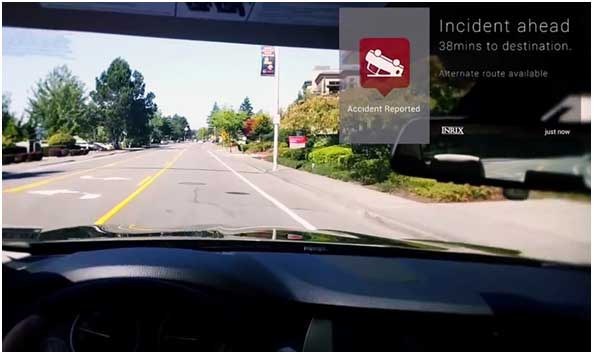 There are a number of Google Glass applications designed to add to your driving experience [1] out there, but INRIX’s real-time traffic app is one of the sexier navigation options. It helps the driver avoid delays in traffic by sending an alert about congestion up ahead and quickly providing a reroute option.
There are a number of Google Glass applications designed to add to your driving experience [1] out there, but INRIX’s real-time traffic app is one of the sexier navigation options. It helps the driver avoid delays in traffic by sending an alert about congestion up ahead and quickly providing a reroute option.
Of course, if the incident causing the congestion is right in front of the driver, he or she can also snap a photo and upload it to the web application, which will then alert other users. The app also allows the driver to send a card to a contact – using simple voice commands – to keep them informed of one’s whereabouts and estimated arrival time. It’ll even furnish you with a summary of your trip – including how much time you the rerouting saved you.






